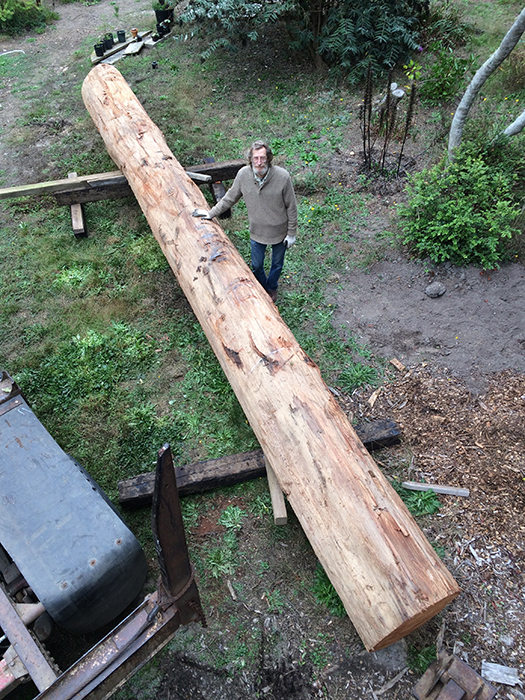Pole Commission
In early summer of 2015 I was asked if I was interested in doing a totem pole for a location on the Ten Mile River just north of Fort Bragg CA.

Me and the Log
The log is 25 feet long and about 24″ in diameter. This allows for 18 feet of carving and 7 feet to be buried in the ground.
The term “totem pole” is problematic for me. It calls to mind so strongly the poles carved by the First Nation people of the pacific North West. These poles are highly stylized and exist in a rich cultural context that gives them meaning and emotional content.
As a contemporary artist I don’t have available to me a style or cultural understanding that allows for anything like the complexity of the First Nations pole as a transmitter of information.
I start from the desires of the client as to visual content and emotional impact and use my understanding and emotional ties to my subjects to try to convey the requested content.
The request from the client stated “As I understand it, the totem poles invoked and grounded their relationships with various spirits of protection, abundance, guidance, etc. For me, the idea includes this as well along with the intention to create a visual/physical reminder of relationship, gratitude, dialogue and welcome for those spirits who are endemic to this place and for some of the other spirits with whom we feel closely connected. The local animal spirits include salmon and whale primarily, and also possibly beaver, owl, heron, sea lion, shark, raven (of course!) and perhaps others.

Location
A small diameter pipe is raised at the proposed location
With this outline of the intent of the pole, and after a visit to the site, I began working on identifying animals and how to arrange them visually on the pole.

First Sketch
The first of the clay sketches
As is usual for me I began working up some ideas in clay, or specifically plastilina, an oil based clay that does not dry or harden. This allows me to explore ideas in the round, doing quick sketches that are easily modified. The first complete model was 36” tall. After meeting with the client and hearing her thoughts a second model was executed. After further conversations and a few more changes we came to a comfortable agreement on the design.

Second Sketch
Developing on the first sketch here I have added some details including a pair of snakes coiling up and down the pole.

Third Sketch
This is the final sketch, done after I had the log and incorporating the faults and actual size of the log. I have simplified the design, removing the snakes and adding the pair of nursing bear cubs.
Carving in wood is not like digital 3d printing. The wood has its say in the final result. Its cracks and twists cannot be ignored. It has hidden knots and scars that will not reveal themselves until the work is underway. As I carve my ideas change in dialogue with the wood and with the intense relationship to the images themselves that evolve in the many hours of carving. Much trust is needed; on my part a trust that the image is in the wood somewhere, and the trust of the client that as the carving varies from the approved design to fit the reality of my skills and the woods limitation, the result will be accord with the original intent.
This project is a challenge due to its scale. The pole is 18 high, and it started out as 2 feet in diameter. I would need to work on it lying on the ground.

The Log Arrives
The Redwood log is what is termed a “buckskin,” meaning it was cut at some time in the past and not considered worth hauling out to be milled. It was located in an active logging site on the Ten Mile river and hauled up to a landing. From there it was picked up by a self loading log truck and delivered to my studio.






